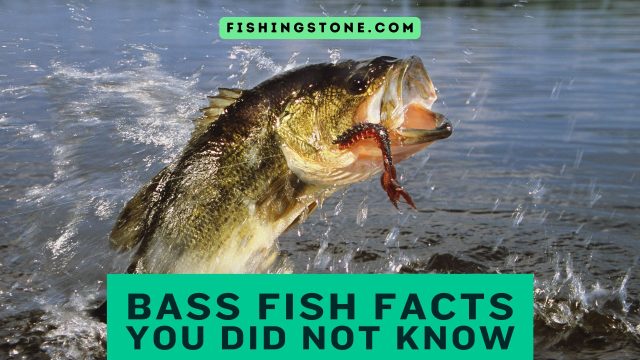Bass Fish Facts – Bass fishing is fun and popular. Get interesting facts about bass that can help you catch more fish. Read on for quick tips.
Bass Fish Facts That You Did Not Know

Bass Fish Facts That You Did Not Know
Are you fascinated by bass and their role in lakes, rivers, and oceans? These fish aren’t just popular among anglers—they’re also key players in ecosystems. Many people think they know everything about bass, but the truth is, they hold many secrets.
Some bass fish facts will surprise even experienced fishermen and researchers alike. In this article, you’ll discover surprising details about their biology, habits, ecology, and even some fun trivia. Get ready to see bass from a whole new angle.
DISCLOSURE: Some of the links on this page are affiliate links, meaning, that at no additional cost to you, I may earn a commission if you click through and make a purchase. Affiliate commissions help fund this website, our rare fishing trips and my extreme coffee addiction.
Frequent Asked Questions About Bass Fish
As an avid angler and someone deeply fascinated by freshwater aquatic life, I often find myself fielding questions about one of North America’s most popular game fish: the mighty bass. These powerful, intelligent fish are a true joy to pursue, and for good reason! Whether you’re a seasoned pro or just starting out, there are always things to learn. Here, I’ve compiled some Frequent Asked Questions About Bass Fish that I commonly encounter, hoping to shed some light on these incredible creatures.
One question I frequently get asked is about the different types of bass, as it can be a bit confusing given their diverse appearances and habitats.
What are the main types of bass?
When people talk about “bass” in freshwater fishing, they’re typically referring to members of the Micropterus genus, often called black bass. The most common species I encounter are:
- Largemouth Bass: Easily identifiable by its jaw extending beyond its eye, the largemouth is the most widespread and iconic bass species. They prefer warm, weedy waters.
- Smallmouth Bass: Known for their fighting spirit and bronze coloration, smallmouths have a jaw that doesn’t extend past the eye. They thrive in cooler, clearer waters with rocky bottoms.
- Spotted Bass: Often confused with largemouths, spotted bass have a smaller mouth and distinct rows of spots on their lower flanks. They are common in southern states and often inhabit rivers and reservoirs.
Beyond these, there are also less common species like shoal bass, redeye bass, and Guadalupe bass, each with their unique characteristics and geographical ranges.
Where do bass typically live?
From my experience, bass are incredibly adaptable. Largemouths love structure like lily pads, submerged timber, and brush piles in lakes, ponds, and slow-moving rivers. Smallmouths, on the other hand, prefer the rocky points, drops, and currents of cooler lakes and rivers. They are found throughout North America, from Canada down to Mexico, adapting to a wide array of aquatic environments.
What do bass eat?
Bass are opportunistic predators, and from what I’ve observed, their diet is quite varied depending on their size and environment. As juveniles, they’ll feast on insects and small crustaceans. As they grow, their palate expands to include:
- Baitfish (minnows, shad, shiners)
- Crayfish
- Frogs
- Worms
- Small rodents, lizards, and even small birds (especially for large adult bass)
Their aggressive feeding habits are precisely why they’re so much fun to catch!
Are bass good to eat?
This is a personal preference, but yes, many people consider bass to be excellent table fare. I find their white, flaky meat to be quite mild. However, I often practice catch-and-release, especially for larger breeding fish, to help sustain the population. If you do keep bass for consumption, ensure they come from clean waters and adhere to local regulations regarding size and bag limits.
How long do bass live?
The lifespan of a bass varies greatly depending on the species, water quality, food availability, and fishing pressure. Generally, I’ve seen largemouth bass live from 6 to 10 years in the wild, though some can reach up to 15 years in ideal conditions. Smallmouth bass typically have a similar lifespan, sometimes slightly longer in very cold, pristine waters.
“The state record is 4.6 kg (10 lbs 2 oz). A largemouth bass can live up to 15 years, but fish over 10 years old are rare.” ~ University of Minnesota
“Fishing is not an escape from life, but rather a deeper immersion into it.” — Harry Middleton
I hope these answers provide a clearer picture of bass fish and why they hold such a special place in the hearts of anglers. Understanding these magnificent creatures only enhances the joy of pursuing them on the water.
Little-Known Bass Fishing Facts and Techniques
- If you like our video above please follow us on YouTube!
Many anglers don’t realize that bass respond better to subtle movements than loud ones. Using a slow, steady retrieve can trigger bites more than quick pulls. The water temperature plays a big role—bass stay deep and slow down in cold water. Sometimes, switching to a less common lure like a finesse worm or small jig catches more fish. Fishing during low light — early morning or late evening — increases your chances.
It’s also useful to hunt for clean, rocky areas where bass hide from predators. Changing your depth often helps find where bass are feeding. Clear water calls for lighter line and more natural bait, while murky water means heavier lures and bright colors. Anglers overlook that baitfish patterns mimic real prey better than flashy ones, sinking faster to bass’s comfort zone. Patience and reading the water can turn a slow day into a good catch.
Bass Senses and How They Detect Prey
You probably know bass have good eyesight, but their senses do much more. Their lateral line system detects the slightest water movement, helping them spot prey—even in murky water. Bass also rely heavily on their sense of smell to identify food or recognize rivals.
Pro fishermen use this knowledge by fishing near structures where bass are likely to patrol. Using lures that vibrate or produce subtle underwater sounds can trigger a bass’s natural instinct to strike.
“Fish are caught less often as they learn to avoid baits and lures. A recent INHS study evaluated the question of how that learning happens.” ~ Illinois.edu
Bass Feeding Habits and Diet
While bass love eating other fish, their diet can surprise you. They’ll often go after insects, crustaceans, or even small birds! During colder months, their feeding shifts to slower-moving prey like crawfish and small fish.
Innovative bait and lure choices reflect these habits. For example, using crawfish-shaped lures or feathered jigs mimics their natural prey. Seasonal changes mean anglers need to adapt: in spring, Rooster Tails are great; in summer, topwater lures can bring big bites.
Then again, they might not. Fish are very picky. What works great one day might not get you a single bite the next. Always bring a good supply of lures and try different ones till you find the one that works that day.
“Bass begin to eat fish when they are about 2 inches long. They swallow live fish and
other aquatic life whole rather than biting off chunks, which limits the size of what they can eat.” Agriculture College
Myths and Misconceptions About Bass Behavior
Many believe bass only bite when the water is warm or when it’s sunny. That’s a myth. Bass are active in overcast weather and even during colder days, if conditions are right. They also don’t only bite at midday—early morning and dusk can be equally productive.
Understanding bass behavior helps anglers fish smarter, even in less-than-ideal conditions. Sometimes, the “bad” weather is the best time for catching bass—if you know how they behave.
The Biological Wonders of Bass Fish
Bass fish are remarkable for their strong muscles and fast growth. They can live in both fresh and brackish water. Their sharp teeth help them catch quick prey like smaller fish and insects. Basses have excellent eyesight, which makes hunting easier. They have a swim bladder that helps control their depth and stay balanced.
Some bass species can change color slightly to blend into their surroundings. Their lateral line system detects vibrations in the water, warning them of danger or prey nearby. These fish reproduce quickly, laying thousands of eggs at a time. Their aggressive nature makes them fierce hunters. Overall, bass fish show a mix of speed, strength, and adaptability.
Unique Bass Fish Physical Adaptations That Boost Survival
Bass fish have evolved amazing features that help them survive in different environments. Take their jaws: largemouth bass, for example, have a mouth that can gulp down prey whole—perfect for ambushing smaller fish.
Smallmouth bass boast stronger, more muscular jaws that crush shells and tough prey. Striped bass, which swim in saltwater and freshwater, have a sleek body shape aiding rapid movement through water. Their coloration varies based on habitat but often helps them blend—their mottled patterns are camouflage against the riverbed or lake plants.
Bass also have highly sensitive lateral lines—thin strips along their sides—that detect movements and vibrations in water. This sensory system lets them “hear” prey hiding nearby or watch predators lurking around. Such adaptations give each bass species a sharp edge in their habitats.
Growth Rates and Lifespan of Bass
Many anglers assume bass grow slowly, but that’s not always true. A largemouth bass can grow a foot long in just four years in ideal conditions. Some can live as long as 16 years in the wild. Interestingly, smallmouth bass tend to live longer than largemouth, sometimes reaching 20 years.
Growth and lifespan depend heavily on location, diet, and water quality. Warmer waters often speed up growth but can also shorten lifespan if the environment becomes overrun with pollutants. Conversely, healthy habitats lead to bigger, longer-lived bass.
Bass Reproductive Mysteries and Mating Behaviors
Bass are known for their territorial nature during spawning. Did you know male bass build protective nests and guard them fiercely? They usually do this in shallow waters, often near submerged structures or plants. They can spawn up to three times a year, depending on the species and region.
Bass communicate through sound and movement—males often vibrate their bodies to attract females. This “drumming” releases low-frequency sounds that resonate underwater, signaling their readiness to mate. Watching bass court each other reveals a fascinating dance of flashing colors, gentle nudges, and territorial displays.
Ecological Significance and Habitat Insights of Bass
Largemouth and smallmouth bass play key roles in aquatic ecosystems. They control populations of smaller fish and invertebrates. Their presence indicates good water quality and healthy habitats. Bass prefer clear waters with plenty of rocks, weeds, and submerged structures. These features give them hiding spots and breeding sites.
During spawning, bass build nests and need quiet areas to protect their young. They serve as prey for bigger fish, birds, and mammals. Protecting bass habitats helps maintain a balanced food chain. Their health reflects the overall state of the water environment. Conserving these fish means keeping waters clean and full of life.
Bass as Indicator Species for Ecosystem Health
Bass are like the canaries in a coal mine for aquatic environments. Their numbers and health reflect water quality because bass need clean, oxygen-rich water to thrive. If bass populations drop, scientists often see a sign of pollution or habitat degradation. They’re natural gauges of ecosystem stability, offering clues about the long-term health of lakes and rivers.
Range and Habitat Preferences Across Regions
Native to North America, bass occupy lakes, ponds, and rivers across the continent. Largemouth bass prefer warm, slow-moving waters with lots of vegetation. Smallmouth bass favor cooler, rocky rivers and lakes. Striped bass, once native to Atlantic waters, have been introduced into many inland waters and even the Great Lakes.
Each species has specific needs: bass thrive in temperatures between 60 and 75°F, with plenty of submerged structures or aquatic plants to hide in. Knowing these preferences helps anglers find prime spots and supports conservation efforts.
Impact of Climate Change on Bass Distribution
Climate change is shifting where bass can live. Rising temperatures cause spawning times to change and move to different locations. Some bass are now found in colder waters farther north, while others struggle to survive in warming lakes.
For anglers and conservationists, staying adaptable is key. It’s wise to learn new areas and adjust fishing techniques as bass migrate or change in number. Protecting current habitats and restoring damaged ecosystems also help keep bass populations healthy amid climate shifts.
Bass Fish Scientific Research and Conservation Efforts
Bass scientific research focuses on understanding bass populations and their habits. Scientists study how bass grow, where they live, and what influences their numbers. This research helps find better ways to protect bass from threats like pollution and overfishing. Conservation efforts include setting fishing limits, creating protected areas, and restoring habitats. These actions aim to keep bass populations healthy for future generations. Better data from research guides these measures, making them more effective. Overall, research and conservation work together to ensure bass stay a vital part of freshwater ecosystems.
Recent Breakthroughs in Bass Genetics and Physiology
Scientists now use genetic testing to understand different bass populations better. This helps identify which stocks are endangered or thriving. Physiological studies reveal how bass adapt to changing environments, such as developing higher tolerance to pollution or temperature shifts.
Such research supports a better management of bass fisheries and helps preserve genetic diversity within species.
Conservation Challenges and Success Stories
Overfishing and habitat destruction threaten many bass populations. Pollution can cause die-offs, especially during breeding seasons. However, conservation organizations have had wins, like restoring native habitats and promoting catch-and-release programs.
One success story: marine protected areas where bass thrive because fishing is limited. These efforts show that scientific understanding combined with community effort can reverse declines.
How to Support Bass Populations and Habitats
If you love fishing, do your part by practicing catch-and-release and following local rules. Plant native aquatic plants in your area—these create ideal spawning beds. Participating in habitat cleanup days and supporting conservation groups also makes a difference.
Every action counts in maintaining healthy bass populations for future generations.
Thank You For Reading Our BASS FISH Facts That You Did Not Know Post

Knowing how big bass can grow and how they move helps us appreciate their role in lakes. They are fierce predators, adapt in many ways, and even change color to hide. Watching their behaviors makes fishing more exciting and boosting your knowledge easier. Keep studying these fish to enjoy catching them and caring for their habitat even more. The bass is truly an interesting fish to learn about and pursue.
Bass fish are more than just popular targets for anglers—they’re complex creatures with remarkable adaptations and important ecological roles. Learning these lesser-known bass fish facts reveals how much there is to discover about them. By understanding their biology, habitat needs, and behaviors, we can better protect and enjoy these fascinating fish. Whether you’re casting a line or studying water quality, your knowledge fuels conservation and fun alike. Dive into the world of bass and see how much more there is to love about these aquatic legends.
Happy fishing!
We post on several sites on Socia Media. By joining us on your favorite ones you can get updates on our latest Fishing Posts.
Find us on Facebook – Twitter – Pinterest – YouTube
Hope you have fun Fishing every day. Fish On!

















Hi there it’s me Fiona, I am also visiting this website daily, this website is in fact nice and the viewers are truly sharing good thoughts. They grow fast, with some reaching over 10 pounds. Using the right gear, like medium-heavy rods and fast action reels, boosts your success. Pay attention to the water’s temperature and weather, as these factors influence bass activity. Smallmouth and largemouth bass have different habits but both love shaded areas. Knowing these facts helps you plan better trips and catch more fish.
Bass fish are known for their sharp senses and quick movements. They prefer clear water and structure like rocks, plants, or fallen trees. During the warmer months, bass tend to stay close to the surface, making them easier to catch. They often strike lures that mimic small fish or insects. Casting near cover increases your chances of a bite. Bass are most active early in the morning and late in the evening.